
views
Combating Algae Growth
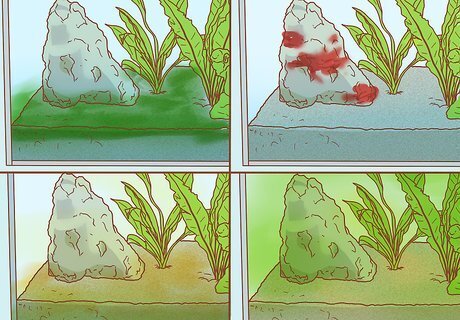
Determine the different colors of algae in your tank. Different kinds of algae thrive in different aquarium conditions. Look in your tank for the 4 main types of algae—blue-green, red, brown, and green—and rank them from most prevalent to least prevalent. From here, focus most on the procedures that work on the most prevalent algae in your tank. Blue-green algae thrive in general poor water conditions. They develop on your fish, which will eventually start to look moldy—especially when they're motionless. Red algae are caused by a lack of carbon dioxide and hang all over your aquarium in threads. Brown algae thrive in conditions with a lack of adequate light and form in large, brown layers. Green algae are caused by too much light and can make your aquarium look like pea soup.
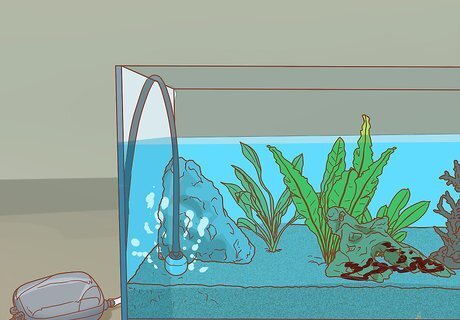
Boost carbon dioxide levels in your aquarium to starve red algae. Oxygen works to starve algae, which prevents them from growing. Invest in aeration devices such as airstones, bubble disks, and air pumps. This will boost carbon dioxide levels and even add give your fish some fun items to play with. Purchase carbon dioxide boosters from pet stores and online suppliers.
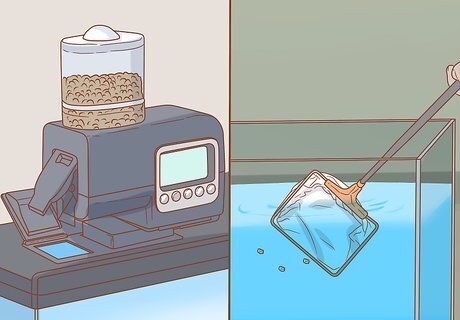
Decrease excess food to remove algae nutrition for blue-green and brown algae. Although fish need food to survive, too much leads to high ammonia and phosphate levels in your tank. The end result is often increased algae growth. Always stick to small portions of food that your fish can eat quickly to keep your tank clean and maintain a steady, effective feeding schedule. Ideally, you should feed your fish 1 to 2 times daily with minimal portions. Take note of leftover foods—if you see any, decrease the size of the next batch of food. Use an automatic feeder to ensure timely feeding and prevent overfeeding.
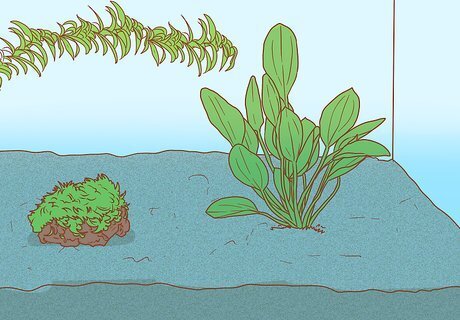
Add live plants to your aquarium to decrease brown and green algae. Live plants provide algae with resource competition and inhibit their growth. Over time, they starve algae by consuming excess nutrients in the water that are needed for algae survival. Start by adding 1 or 2 and increase the amount if necessary. Use Java Moss, Amazon Sword, Java Fern, Hornwort, Dwarf Lilies, Water Wisteria, and Crypt Wendtii for the best results. Keep an eye on algae levels after adding plants to gauge their effect. If algae levels aren't changing, add more plants! Be aware that some plants do not do well with high powered filters. Find a balance between filtration, your fish species, and the type of plants that they can be housed with.
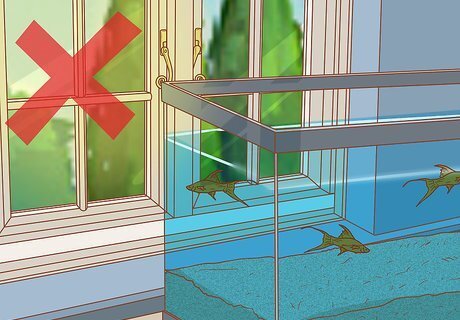
Decrease your tank's light exposure to prevent green algae growth. Keep the aquarium away from unshaded windows and only turn the aquarium lights on when viewing your fish. This will decrease green algae levels tremendously. In addition, always keep your tank out of direct sunlight for the best results. If you need to put your aquarium near a window, install some curtains so you can control the light exposure of your aquarium. In general, about 8 to 12 hours of light per day is ideal for aquariums with plants. Decrease your aquarium's light exposure to 6 to 10 hours a day if it doesn't have plants. Connect your lights to automatic timers to control light exposure. If decreasing light exposure isn't working, trying decreasing the intensity of your lights. Change your light bulbs at least once a year.
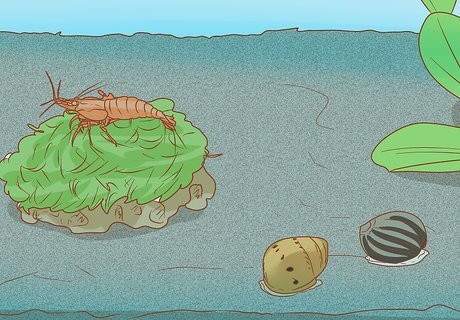
Introduce algae-eating fish, shrimp, and snails into your aquarium. The catfish, bushy-nosed pleco, and Siamese algae eater are common algae-eating fish. For shrimp, stick with Amano Shrimp and Red Cherry Shrimp. Any freshwater snail will likely be effective. Nerite snails, Mystery Snails, Ivory Snails, and Gold Inca Snails are all great choices. In terms of fish for saltwater tanks, angelfish, blennies or tangs are great choices. Don't rely solely on algae-eating species to control your problem.
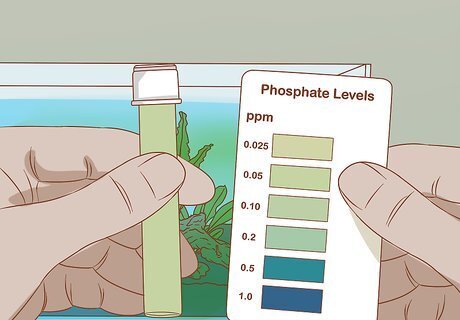
Keep phosphate levels below 0.05 ppm. Higher phosphate levels can lead to algae proliferation. Purchase a test kit for phosphate from a local aquarium. Now, fill the tube to the required level and add your testing solution. Shake the tube and match the water color to the provided chart to determine the phosphate levels. Add poly filters or a carbon-phosphate remover to the tank to decrease phosphate levels.
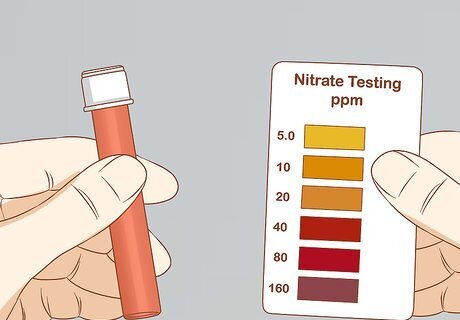
Maintain nitrate levels between 20 and 40 ppm. The presence of nitrate can help algae grow. Head to a local aquarium and purchase a nitrate testing kit. Now, fill the test tube to the indicated level, add your testing solution, and shake the tube. Match the color of the water to the testing kit's chart to determine nitrate levels. Change water weekly to keep nitrate levels low.
Maintenance Procedures
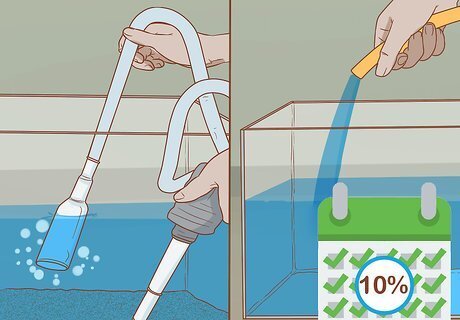
Swap at least 10 percent of your water daily until the algae are gone. Use a bucket to remove 10 percent of the water daily. Either remove the water manually or use it with a siphon if you want to minimize heavy lifting. After removing 10 percent of the water, fill the tank up with filtered water. If you're adding cold water, make sure the temperature is acceptable for the species of fish in your tank. Use a water conditioner when swapping water. A 10 percent daily swap means you should be switching your water completely every 10 weeks. Do not swap more than 20 percent of the aquarium water daily. For saltwater tanks, add ½ cup (118 grams) of sea salt per 1 gallon (3.8 L) of water and mix it thoroughly.
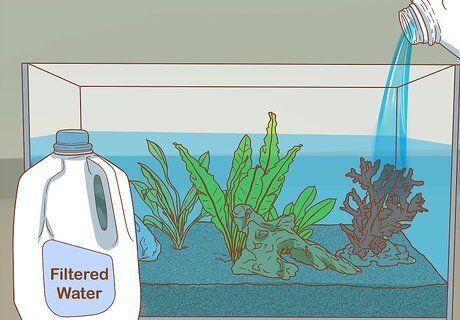
Fill your tank with filtered water. Although well water and tap water can work for some freshwater tanks, your safest bet is filtered water. The former options typically contain high levels of nitrates and phosphates, which increase algae growth. Use a filter that is meant for 20–40 gallons (75.7–151.4 L) more than the size you actually have. For example, a 40 gallon (150 L) tank should have a 60 to 80 gallon (230 to 300 L) filter. Never replenish your tank with well or tap water. Purchase a water filter from a home hardware store or online supplier.

Clean your fish tank once a week to remove waste. Fish waste contains nitrates and ammonia, which promote algae growth. Start by using an algae pad to clean the inside glass by wiping it in circular motions. Afterward, run a siphon-type vacuum along the surface of the gravel. Finally, use an aquarium-safe glass cleaner or a 1:1 solution of vinegar and water, dip a microfiber cloth in it, and wipe down the outer surface of the tank. Wipe off any decorations with your algae pad. For algae that is difficult to remove, use a razor blade or plastic blade to scrape it off. Never let bleach, soap, or other cleaning chemicals get into your water, as they can kill your aquatic life and beneficial bacteria. Create your own gentle aquarium siphon and vacuum if you'd like.
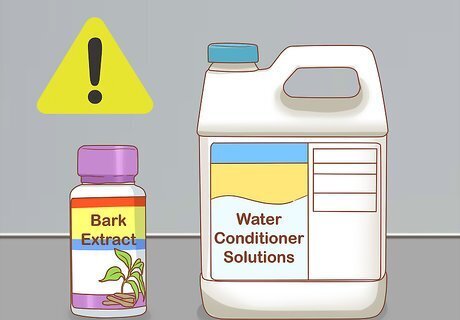
Minimize the use of tank additives. Common additives include bark extract, acid regulators, buffers, salt, and water conditioner solutions. Although tank additives can sometimes help you create a healthy ecosystem, overuse can lead to too many nutrients and cause algae growth. Only use these additives when absolutely necessary. Don't use algaecides unless you haven't had any success with any other options. Most of them contain chemicals that can harm your fish.















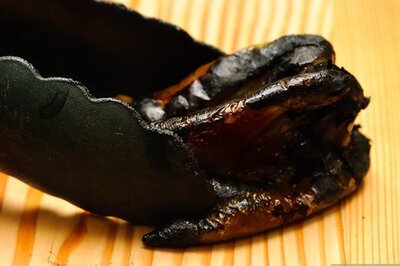


Comments
0 comment